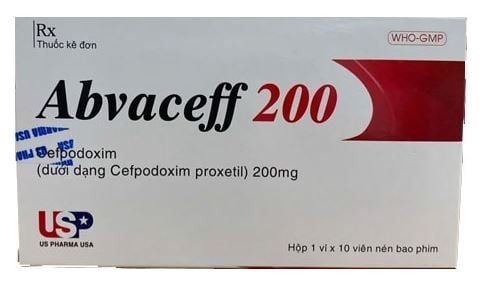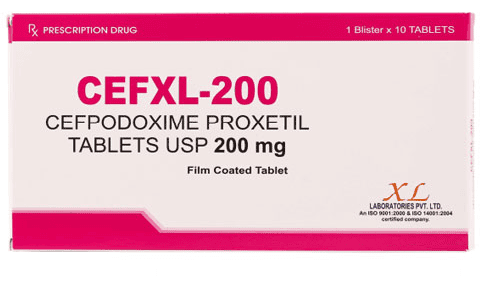This is an automatically translated article.
Vialexin-F1000 is an antibiotic of the Cephalosporin group used to treat infections caused by susceptible bacteria. To use Vialexin-F1000 effectively, patients need to know the uses, dosage and consult a doctor if necessary.
1. Uses of Vialexin-F1000
Cephalexin is the main active ingredient in Vialexin-F1000, a first-generation Cephalosporin antibiotic. The drug inhibits the synthesis of cell envelopes, thereby having a bactericidal effect. Cephalexin is stable to the penicillinase of staphylococci, so it is active against penicillin-resistant strains of Staphylococcus aureus. The antibacterial spectrum of Cephalexin includes:
Streptococcus beta hemolytic; Staphylococcus, including strains secreting Penicilinase, coagulase (+) and coagulase (-); Streptococcus pneumoniae, Escherichia coli ; Proteus mirabilis; Klebsiella spp; Branhamella catarrhalis; Shigella; Haemophilus influenzae but less susceptible. Vialexin-F1000 is used in cases of infections caused by susceptible bacteria in the urinary tract, respiratory tract or in obstetrics and gynecology. Vialexin is not indicated for the treatment of severe infections.
2. Indications and contraindications of Vialexin-F1000
Vialexin-F1000 mg is indicated in infections such as:
Respiratory tract infections: acute and chronic bronchitis, infectious bronchiectasis Infections of the ear, nose and throat: otitis media, sinusitis, tonsillitis. , pharyngitis, mastoiditis Urinary tract infections: cystitis, prostatitis Prevention of recurrent urinary tract infections Gynecological and obstetric infections. Vialexin-F1000 should not be used in patients with a history of hypersensitivity to Cephalosporin antibiotics, penicillin-induced anaphylaxis, and patients with severe IgE
immune-mediated reactions.
3. Dosage and how to use Vialexin-F1000
3.1. How to use Vialexin-F1000 is used orally. Patients should take the entire Vialexin-F1000 tablet, do not chew, break, or crush it because it can reduce the effectiveness of the drug. Vialexin is a prescription drug, so patients only use it when prescribed by a doctor.
3.2. Dosage Adults: 1 tablet/time x 2 -3 times/day, depending on the degree of infection, up to 4 g/day Children: 25 - 60 mg/kg/day, divided into 2-3 oral doses, up to 100 mg/kg/day The duration of treatment is usually 7-10 days, severe cases can be up to 2 weeks In case of gonococcal infection, a single oral dose of 3g Cephalexin + 1g Probenecid for men or 2g Cephalexin + 0.5 g Probenecid for women.
4. Side effects of Vialexin-F1000
Before prescribing Vialexin-F1000, the physician has weighed the benefits against the risk of side effects for each patient. However, some patients may experience undesirable side effects such as:
Common: diarrhea, nausea Uncommon: rash, urticaria, pruritus, eosinophilia, elevated liver enzymes. Rare: headache, dizziness, neutropenia, thrombocytopenia, abdominal pain, pseudomembranous colitis, fatigue, hepatitis, vaginitis, genital pruritus, erythema multiforme, edema Quincke, toxic epidermal necrolysis or Lyell's syndrome Patients should notify their doctor when experiencing unwanted symptoms while using Vialexin, for appropriate management instructions.
5. Vialexin-F1000 . drug interactions
Nephrotoxic drugs such as Aminoglycosides, diuretics such as Furosemide, Ethacrynic Acid or Piretanide, if used with high doses of Cephalosporins, can adversely affect kidney function. Probenecid: decreased renal clearance of Cephalexin should increase plasma concentrations, thereby prolonging the duration of drug action.
6. How to handle when forgetting medication, overdose Vialexin-F1000
Most importantly, the patient should not forget the medicine during treatment. If you have missed a dose, consult your doctor for instructions on taking the medicine. Symptoms of acute overdose: nausea, vomiting and diarrhea, neuromuscular hypersensitivity even causing seizures, especially in people with impaired renal function. Treatment: It may not be necessary to wash the stomach if not taking Cephalexin 5 to 10 times the usual dose or taking activated charcoal in case the amount of overdose is not too much. Supportive treatment includes: ventilatory support, perfusion. Hemodialysis can be used to increase the elimination of drugs from the blood. If the patient has any symptoms after taking an overdose of Vialexin-F1000, they must stop the drug immediately and notify the doctor or go to a medical facility for support and treatment.
7. Note when using Vialexin-F1000
Cephalexin is well tolerated even in penicillin-sensitive individuals, however, there is a small chance of cross-reactivity. Caution should be exercised in people with impaired renal function if Vialexin-F1000 is indicated. Renal function testing is necessary during treatment. Long-term use of Cephalexin may cause overgrowth of less susceptible bacteria such as Enterococcus, Candida, Clostridium There are currently no studies or clinical reports on the potential for fetal malformations if Vialexin-F1000 is used. in pregnant women. However, use only when absolutely necessary and after weighing the benefits against the possible risks. Studies have shown that the concentration of Cephalexin excreted in breast milk is very low, however, caution should still be exercised when administering Vialexin-F1000 to lactating women. Do not operate machinery or drive while taking this medicine because it can cause dizziness, lightheadedness, fatigue. If Vialexin-F1000 tablets are found to be moldy, discolored or watery, absolutely do not use them. Keep the medicine out of reach of children and store in a cool, dry place away from direct sunlight. Above is all information about Vialexin-F1000 drug about uses, dosage as well as important notes that patients need to know before using the drug. If you need more information about Vialexin-F1000, consult your doctor or pharmacist.













